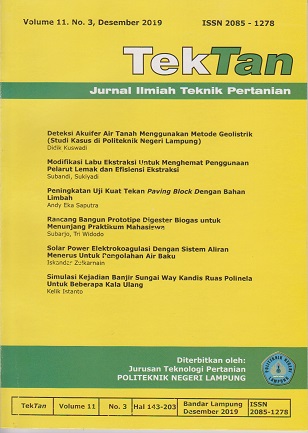Simulasi Kejadian Banjir Sungai Way Kandis Ruas Polinela Untuk Beberapa Kala Ulang
DOI:
https://doi.org/10.25181/tektan.v11i3.1470Abstrak
The effort to control water’s destructive power, in this case is flooding due to overflowing Kandis river, needs to be done to minimize the negative impacts. The main data in flood control infrastructure planning is discharge. The discharge calculation and simulation are required in some return periods. The objectives of research are delineate of catchment area, land cover of catchment area mapping, calculate of maksimum areal rainfall, calculate of flood discharge, and flood simulation of Kandis river in Polinela section base on flood. Kandis river catchment area of the Polinela section was 402.5 hectares and known that type of land cover consists of 15% open land, 20% vegetated land, 50% settlement, and 15% commercial area.The results shown that return period discharge in 2, 5, 10, 20, 25, 50, and 100 year are 9,89 m3/s, 11,81 m3/s, 13,07 m3/s, 14,29 m3/s, 14,68 m3/s, 15,86 m3/s, and 17,04 m3/s. By assuming there will be 1,5 % growth of settlements and commercial areas in catchment area land use as constantly number, 10 years forward, the return period discharge in 2, 5, 10, 20, 25, 50, and 100 year are 10,34 m3/s, 12,33 m3/s, 13,66 m3/s, 14,93 m3/s, 15,33 m3/s, 16,57 m3/s, and 17,80 m3/s. While by assuming there will be 3 % growth of settlements and 1 % growth of commercial areas in catchment area land use as constantly number, 10 years forward, the return period discharge in 2, 5, 10, 20, 25, 50, and 100 year are 10,58 m3/s, 12,63 m3/s, 13,99 m3/s, 15,29 m3/s, 15,70 m3/s, 16,97 m3/s, and 18,23 m3/s. Keywords :river, flood, discharge, flood simulation.Unduhan
Referensi
Alfieri L. 2018. A Global Network for Operational Flood Risk Reduction. Environmental Science and Policy 84 (2018) 149-158. Elsevier.
Arrighi C., Pregnolato M., Dawson R. J., Castelli F. 2019. Preparedness Againts Mobility Disruption by Floods. Science of The Environment 654 (2019) 1010-1022. Elsevier
Asdak C., Sapian S., Subiyanto. 2018. Watershed Management Strategies for Flood Mitigation : A Case Study of Jakarta’s Flooding. Weather Climates Extremes 21 (2018) 117-122. Elsevier
Budiyanto M. A. 2017. Penelusuran Banjir Sungai Luk Ulo Akibat Perubahan Tutupan Lahan. Jurnal Geografi Volume 14 No.1. Januari 2017. Semarang.
Darsono S., Budieny H., Wahyuningtyas A., Pahlevari E. 2017. Pengendalian Banjir Sungai Bringin Semarang. JURNAL KARYA TEKNIK SIPIL Volume 6 No. 3. Semarang.
Figueroa F., Borrero A. C., Fernandez D. R. 2016. “I like to conserve the forest, but I also like the cashâ€. Socioeconomic factors influencing the motivation to be engaged in the Mexican Payment for Environmental Services Programme. Elsevier-Journal of Forest Economics. Canada.
Lestari U. S. 2016. Kajian Metode Empiris untuk Menghitung Debit Banjir Sungai Negara di Ruas Kecamatan Sungai Pandan (Alabio). Jurnal POROS TEKNIK Volume 8 No. 2. Desember 2016.
Maulana A. 2016. Memberdayakan Rencana Detail Tata Ruang (RDTR) Kawasan Strategis Hutan Lindung Sungai Wain dan Sungai Manggar Tahun 2015-2035 dalam Mereduksi Ancaman Kelestarian Lingkungan. Jurnal Wilayah dan Lingkungan Volume 4 Nomor 2, Agustus 2016, 123-132. Semarang
Pramono I. B., Putra P. B.. 2017. Tipologi Daerah Aliran Sungai untuk Mitigasi Bencana Banjir di Daerah Aliran Sungai Musi. Jurnal JPPDAS. Nopember 2017. Surakarta.
Pemerintah Republik Indonesia. 2012. Peraturan Pemerintah Nomor 37 Tahun 2012 tentang Pengelolaan Daerah Aliran Sungai (DAS). Kementerian Sekretariat Negara. Jakarta.
Ruitjer J. 2014. Pengelolaan Daerah Aliran Sungai (DAS). World Agroforesty Center. Pidra – Participatory Integrated Development in Rainfed Areas. Jakarta
Zhang G., Pu J., Mao S. 2018. Research of the Flooded and Vent Area of All Flooded High Expansion Foam System. Procedia Engineering 211 (2018) 996-1003. Elsevier



